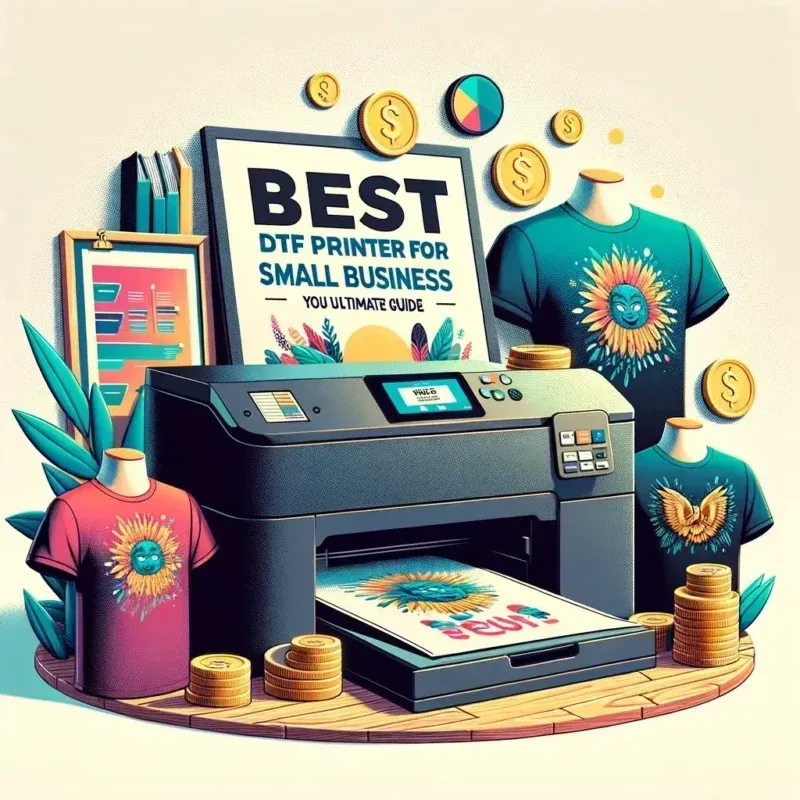Starting your own DTF printing business can be an exciting and lucrative venture, especially in a market increasingly driven by demand for customization and personalization. Direct-to-Film (DTF) printing offers a unique solution that allows entrepreneurs to produce vibrant and high-quality designs that cater to various materials. In this essential guide, we will dive into how to start DTF printing successfully, covering everything from the necessary DTF printing equipment to crucial insights on DTF business setup. You’ll learn about the printing process and modern trends that can help your printing business thrive in a competitive landscape. Equip yourself with the vital knowledge on how to start DTF, ensuring your future endeavors lead to a flourishing printing business.
Embarking on a journey in the custom digital printing sector, particularly through Direct-to-Film (DTF) printing, presents a fantastic opportunity for creative entrepreneurs. This innovative printing method not only ensures a seamless transfer of designs but also caters to a variety of fabric types, making it versatile for numerous applications. If you’re pondering how to launch a successful printing operation, this guide will shed light on essential steps like securing the right DTF printing tools and effectively setting up your DTF venture. We will explore the intricacies of the printing workflow and market strategies that can help your printing enterprise stand out. Discover the potential of the DTF method as a compelling choice in the broader printing business realm.
Understanding DTF Printing: The Basics
DTF printing, or Direct-to-Film printing, is transforming the landscape of custom apparel and textile printing. This innovative process involves printing a design onto a special film, which is then transferred onto fabric using a heat press. One of the hallmark features of DTF printing is its adaptability – it can be applied to a wide variety of materials, making it suitable for everything from cotton t-shirts to polyester jackets. This versatility ensures that anyone starting a DTF printing business can cater to a diverse clientele, tapping into various markets from fashion to sportswear.
Additionally, DTF printing boasts exceptional quality. The prints are vibrant, durable, and can showcase intricate designs that traditional methods might struggle to replicate. By harnessing modern technology and investing in the right DTF printing equipment, entrepreneurs can offer products that appeal to consumers looking for unique, high-quality custom apparel. This capability not only sets businesses apart in a competitive market but also increases customer satisfaction and encourages repeat business.
Essential Equipment for Your DTF Printing Business
To successfully launch your DTF printing business, selecting the right equipment is critical. A quality DTF printer, specifically designed for this printing technique, is the heart of the operation. These printers utilize specialized inks that not only adhere well to the transfer film but also produce stunning, vibrant images. Investing in a reliable printer will lay the foundation for your production quality and efficiency.
In addition to a DTF printer, a heat press is indispensable for your setup. This machine applies the necessary heat and pressure to transfer the ink from the film to the fabric effectively. Proper curing of prints using a heat press ensures that designs remain intact even after multiple washes, making it a worthwhile investment in your DTF business setup. Other necessary tools include transfer film, adhesive powder, and graphic design software, each playing a significant role in the production pipeline.
Step-by-Step Guide to Starting DTF Printing
Starting a DTF printing business requires a structured approach. Begin with the design creation phase where you use graphic design software to develop attractive and marketable designs. It’s crucial to remember that DTF artwork typically needs to be printed in reverse; this is a step that beginners often overlook. Ensuring this preliminary step is correctly executed sets the stage for quality prints later.
Once you’ve prepared your designs, move on to printing them onto the DTF film using your specialized printer. The next vital step is applying adhesive powder to the wet ink, which will help the design adhere to the fabric when heat is applied. Therefore, understanding this fundamental process is essential if you’re looking to navigate how to start DTF successfully and avoid common pitfalls in the early stages of your business.
Marketing Your DTF Printing Services
In the competitive realm of custom printing, effective marketing is paramount for the success of your DTF printing business. Leverage social media platforms like Instagram and Facebook to showcase your vibrant prints and connect directly with potential customers. Regularly posting high-quality images of your work can generate interest and create a loyal following eager to purchase your custom designs.
Consider enhancing your online presence by setting up an e-commerce store using platforms like Shopify or Etsy. This strategy not only broadens your market reach but also facilitates easier transaction processes for your customers. Additionally, participating in local fairs can provide invaluable exposure and allow you to establish a direct line of communication with your target audience.
Conducting Market Analysis for Your DTF Business
A thorough market analysis is a foundational step towards ensuring the viability of your DTF printing business. Identify your potential customer base, which could include niches like custom apparel for sports teams, local businesses, or promotional events. Understanding these markets helps tailor your designs, marketing strategies, and ultimately, improves your product appeal.
Furthermore, keeping tabs on industry trends, competitors, and consumer preferences can provide crucial insights that empower you to position your DTF printing business more effectively. By recognizing demand patterns within your target segments, you can optimize your offerings and adjust pricing strategies, ensuring that you not only attract but also retain customers in a highly competitive landscape.
Staying Compliant and Keeping Your DTF Business Sustainable
Before launching your DTF printing business, it is essential to familiarize yourself with local regulations and licensing requirements. Compliance with local business laws ensures that your operations run smoothly and protects you from potential legal issues. Investigate whether you need any specific permits for the types of materials you’ll be using, as this can vary depending on your location.
Sustainability is also a growing concern in the printing industry. Consider incorporating eco-friendly practices and materials into your DTF printing business model. This not only aligns with the rising consumer preference for sustainable products but also sets a positive precedent in the market. By making conscious choices regarding your operational processes, you can cultivate a responsible brand image that resonates with today’s environmentally aware customers.
Frequently Asked Questions
What equipment do I need to start a DTF printing business?
To start your DTF printing business, you will need essential equipment including a DTF printer (usually a modified inkjet printer), a heat press, transfer film, adhesive powder, and graphic design software like Adobe Illustrator or CorelDRAW. This setup is crucial for successful DTF printing.
How much does it cost to set up a DTF printing business?
The initial setup costs for a DTF printing business can range from $2,000 to $20,000. This depends on factors like the quality and quantity of equipment you choose. It’s vital to create a budget based on your target market and the scale of your operations.
What are the steps to successfully start DTF printing?
To successfully start DTF printing, first design your artwork using graphic design software, then print it on DTF film, add adhesive powder, cure the print using a heat press, and finally transfer the design to your chosen fabric. Each step is important for quality output.
How can I market my DTF printing services effectively?
You can market your DTF printing services effectively through social media platforms like Instagram and Facebook, setting up an online store, participating in local craft fairs, and building a professional website. These strategies will help you connect with a broader audience.
What are the potential markets for my DTF printing business?
Potential markets for your DTF printing business include custom apparel for events, business branding and merchandise, and niche markets like sports teams, schools, or local boutiques. Understanding your audience will help tailor your services accordingly.
Do I need any licensing or permits to start a DTF printing business?
Yes, before starting your DTF printing business, it’s important to check local regulations regarding business licenses and permits. Compliance with safety standards related to printing materials and equipment is also crucial for legal operation.
| Key Point | Details |
|---|---|
| Understanding DTF Printing | DTF printing transfers ink from a special film to various substrates using heat, allowing for versatile applications. |
| Benefits of DTF Printing | 1. Versatility on multiple materials. 2. High-quality vibrant prints. 3. Ease of setup for familiar users. |
| Equipment Needed | 1. DTF Printer (modified inkjet printer). 2. Heat Press (for transferring prints). 3. Transfer Film and Adhesive Powder. 4. Graphic Design Software (like Adobe Illustrator). |
| Initial Setup Costs | Startup costs vary from $2,000 to $20,000 based on equipment quality and quantity. |
| Printing Process | Steps include: Design Creation, Printing on Film, Adding Adhesive Powder, Curing Print, Transferring to Fabric. |
| Market Analysis | Identify markets such as custom apparel for events, branding merchandise, and niche markets like sports teams. |
| Sales and Marketing Strategies | Utilize social media, set up an online store, participate in local events, and build an online presence. |
| Regulations and Licensing | Check local regulations, permits, and safety standards before starting your business. |
| Continuous Learning | Engage in communities, attend webinars, and follow industry updates to keep skills current. |
Summary
Starting your DTF printing business is not just a journey into enterprise; it’s a gateway to providing unique and personalized products to customers. With the increasing demand for custom print solutions, understanding the nuances of DTF printing technology is essential. By grasping the key equipment needed, the efficient printing process, and the importance of market analysis and marketing strategies, you position your business for success. Cultivating a continuous learning mindset will allow you to adapt to industry trends and foster innovation within your offerings. Immerse yourself in the world of DTF printing, and you will find ample opportunities to thrive as a business owner in the creative marketplace, catering to diverse clientele with passion and skill.



